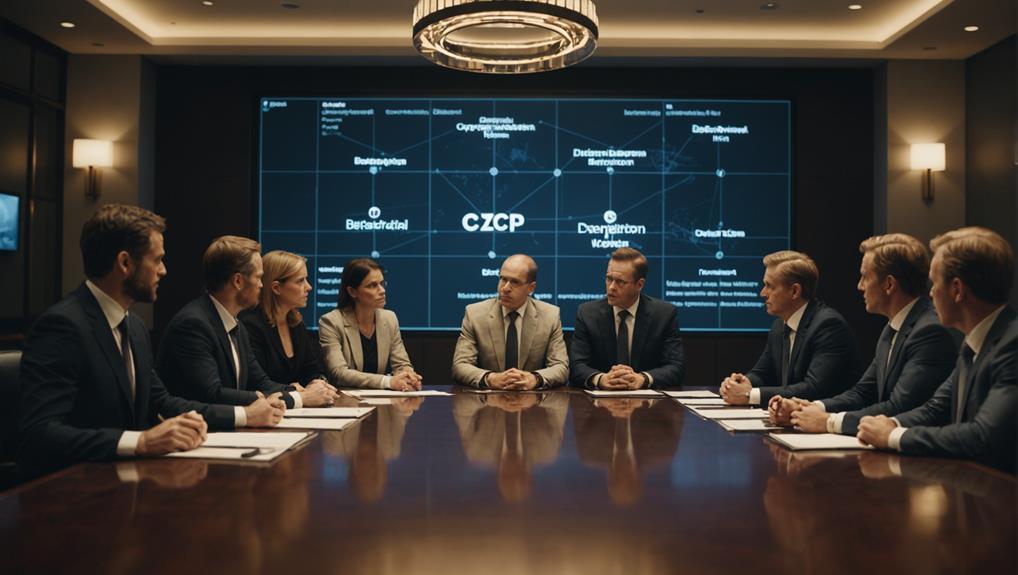Navigating Power Dynamics in Leadership Alignment in Mergers and Acquisitions

Avoiding power struggles within leadership alignment during mergers and acquisitions requires a united vision among leaders, promoting transparent communication and strategic cooperation.
Prioritizing the integration of organizational cultures is crucial to ensure all leaders are in sync.
Making swift decisions within a cohesive leadership team is vital for adapting quickly to changing circumstances.
Embracing emotional intelligence assists in handling conflicts and fostering trust among team members.
Clearly defining roles early on helps to prevent conflicts and alleviate uncertainties, while continuous learning enhances adaptability.
By concentrating on these aspects, we pave the way for a smooth and prosperous merger integration.
Let's delve into effective strategies to guarantee success.
Key Takeaways
- Define specific roles and responsibilities to minimize confusion and prevent potential disagreements.
- Foster a culture of transparent and honest communication to build trust and encourage collaboration among leaders.
- Establish effective conflict resolution strategies to address any issues proactively and prevent them from escalating.
- Emphasize the importance of emotional intelligence in managing interpersonal conflicts and navigating complex power dynamics.
- Conduct regular feedback sessions to ensure that a variety of perspectives are considered and integrated into decision-making processes.
Understanding Leadership Alignment
Leadership alignment in mergers and acquisitions entails aligning the visions and strategies of key executives. When leaders share a common vision, it facilitates effective communication and strategic planning. This alignment serves as the cornerstone for navigating the complex power dynamics inherent in M&A activities.
Leadership alignment goes beyond mere agreement; it involves fostering a collaborative leadership culture where each executive is empowered to contribute to the collective vision. Effective communication plays a pivotal role in ensuring that all viewpoints are taken into account, making the strategic planning process inclusive and transparent.
Insights from C-Suite Impact Deal Makers underscore the significance of a shared vision in driving successful outcomes. A unified leadership approach, facilitated by a shared vision, positively impacts key indicators of deal success. Embracing leadership alignment allows for better management of the power dynamics commonly encountered in M&A transactions.
This collective recognition ensures that leadership remains cohesive and strategic, leading to a smoother integration process and sustained prosperity. It's essential to remember that strategic alignment isn't just a goal but an ongoing journey.
Synchronizing Visions and Strategies
Aligning visions and strategies in mergers and acquisitions ensures that all leaders are working towards a unified objective, promoting a collaborative and efficient integration process. When leadership is aligned, a shared vision is established, reducing conflicts and fostering collaboration. Strategic alignment of leaders ensures that key stakeholders are in sync, managing the power dynamics inherent in M&A transactions. This synchronization is crucial for improving decision-making processes and driving successful outcomes.
To achieve this, we must focus on:
- Leadership Alignment: Ensuring all leaders have a common vision.
- Shared Vision: Creating a unified goal for all stakeholders.
- Strategic Leadership: Guiding the integration process effectively.
Leadership alignment goes beyond agreeing on a strategy; it involves creating a cohesive environment where every decision is guided by a shared vision. By harmonizing visions and strategies, we can navigate the complex power dynamics that often arise during mergers and acquisitions.
This approach not only streamlines the integration process but also sets the stage for long-term success, ensuring that the merged entity is poised for innovation and growth.
Shared Vision and Communication

When we align our leadership visions, we lay the groundwork for open and honest dialogue crucial for M&A success.
Ensuring our communication strategies prioritize clarity and consistency is key to fostering collaboration and unity among leaders.
Synchronizing Leadership Visions
In mergers and acquisitions, establishing a shared direction is crucial for success. This requires clear and effective communication among leaders to ensure alignment and a unified vision. When leaders are synchronized, they can work together towards common goals, leading to positive outcomes for the merger or acquisition.
To synchronize leadership visions, it's important to implement certain practices. Regular strategy meetings help keep everyone informed and address any potential misalignments promptly.
Transparent goal setting is essential for measuring success and tracking progress throughout the process. Additionally, inclusive decision-making, where input from all leaders is encouraged, fosters collaboration and a sense of ownership among the team.
Enhancing Transparent Dialogue
Creating an environment of open dialogue is crucial in aligning leadership teams and fostering a shared vision in mergers and acquisitions. Prioritizing transparent communication helps mitigate power dynamics and enhances collaboration in decision-making processes. Open dialogue cultivates trust, reduces uncertainty, and nurtures a cohesive leadership culture, enabling synchronization of strategies, goals, and priorities with precision.
Effective communication strategies ensure that everyone is working towards common objectives, promoting clarity and understanding of different perspectives. This alignment of leadership visions fosters a unified approach to the challenges at hand.
Transparent dialogue impacts various aspects of M&A:
- Trust Building: Honest communication nurtures trust among leaders.
- Reduced Uncertainty: Open dialogue minimizes ambiguity and confusion.
- Cohesive Culture: Promotes a unified and collaborative leadership environment.
Open dialogue is a cornerstone of successful mergers and acquisitions, facilitating understanding, alignment, and teamwork towards positive outcomes. Prioritizing transparent communication helps navigate power dynamics effectively and creates a shared vision for achieving collective success.
Cultural Integration
During the initial phases of a merger, it's paramount to prioritize the integration of cultures to ensure a smooth transition and a cohesive organizational atmosphere. A critical aspect in this process is ensuring alignment among leadership teams, as they play a pivotal role in driving effective integration efforts. The ultimate goal is to achieve a successful integration where communication flows seamlessly, and the cultural fabric of both organizations blends harmoniously.
To facilitate this integration, several strategies can be employed:
- Cross-cultural training: Providing employees with the necessary tools to understand and respect the new cultural dynamics.
- Establishing a common language: Introducing shared terminologies and communication protocols to bridge any existing gaps.
- Promoting cultural sensitivity: Encouraging empathy and open-mindedness towards diverse practices and beliefs.
These strategies go beyond mere checkboxes; they're vital for fostering unity, collaboration, and a shared sense of purpose post-merger.
Any misalignment in cultural integration can lead to significant challenges such as employee disengagement, resistance to change, and reduced productivity. Therefore, it's imperative to address cultural integration thoughtfully and proactively.
Agile Decision-Making

Agile decision-making plays a crucial role in mergers and acquisitions as it enables us to quickly adjust to changing circumstances and capitalize on new opportunities. In the fast-moving realm of M&A, dynamic environments necessitate timely and well-informed decisions to stay competitive. Embracing agile decision-making ensures that leadership alignment is maintained, allowing us to leverage strategic advantages effectively.
Swift decision-making is essential for maintaining momentum in deals, preventing stagnation, and promoting a proactive approach to unexpected challenges. Flexibility and the ability to pivot and adapt strategies in response to shifting market conditions are key to mitigating risks and enhancing responsiveness, ultimately keeping us ahead in a constantly evolving landscape.
Leadership alignment in agile decision-making ensures that our leaders are united in purpose, working together seamlessly to drive the M&A process forward. This cohesion facilitates clear communication and rapid decision implementation, strengthening our ability to achieve desired outcomes.
Essentially, agile decision-making equips us with the necessary tools to navigate the complexities of M&A, fostering innovation and forward-thinking to seize every opportunity that arises.
Collaborative Leadership Culture
In a collaborative leadership culture, we prioritize open communication to ensure that all voices are valued, especially in the context of mergers and acquisitions.
By fostering cross-functional synergy and tapping into diverse expertise, we drive innovation and collective problem-solving. This approach not only aligns leadership but also fortifies the entire organization, increasing our likelihood of success in navigating mergers and acquisitions effectively.
Through this collaborative leadership style, we pave the way for a seamless integration process and a unified vision for the future of our organization.
Encouraging Open Communication
Facilitating open communication among leaders is crucial for establishing trust and collaboration during mergers and acquisitions. Prioritizing transparency and encouraging honest dialogues creates an environment that fosters trust and aligns diverse leadership styles towards common goals. This approach lays the foundation for more productive discussions and effective conflict resolution.
To cultivate a culture of open communication, it's essential to focus on:
- Creating safe spaces for leaders to express their thoughts and concerns without fear of judgment.
- Encouraging regular feedback sessions where ideas can be freely exchanged and assessed.
- Advocating for transparency in decision-making processes to ensure everyone feels informed and valued.
Cross-Functional Synergy
To drive innovation and problem-solving, we should cultivate a collaborative leadership culture that fosters cross-functional synergy. This approach encourages leaders from various departments to openly exchange ideas and feedback, leveraging our collective expertise to the fullest. By nurturing an environment that values diverse perspectives, we enhance our decision-making processes.
In the realm of mergers and acquisitions, effective cross-functional teamwork is crucial for achieving shared goals. When leaders with diverse backgrounds collaborate, they bring unique insights that stimulate innovation and enable us to tackle complex challenges more efficiently. Promoting a culture of collaboration ensures that all viewpoints are considered, creating an inclusive environment where different perspectives shape our strategic decisions.
This synergy goes beyond just problem-solving; it plays a key role in driving organizational success. A culture that prioritizes cross-functional collaboration helps us navigate the complexities of M&A activities, ensuring that our objectives and resources are aligned effectively. By promoting the open exchange of ideas, we build a resilient organization capable of adapting and thriving in dynamic settings.
Embracing a collaborative leadership culture ultimately leads to more informed decision-making, stronger team dynamics, and a solid foundation for sustained growth and prosperity.
Managing Power Struggles

Addressing power struggles early is crucial for ensuring smooth leadership alignment during mergers and acquisitions. When leaders from different organizations come together, conflicting priorities, egos, and diverse decision-making styles can create friction. If these power struggles aren't managed effectively, they can lead to delays, hinder decision-making, and impact the overall success of the M&A process.
To foster cohesion and drive successful integration, it's important to focus on conflict resolution and open communication. By doing so, potential conflicts can be turned into opportunities for collaboration.
Here are some strategies for managing power struggles:
- Establishing Clear Roles and Responsibilities: Clearly defined roles help mitigate conflicts by setting expectations and reducing ambiguity.
- Promoting Open Communication: Encouraging dialogue ensures that all voices are heard, fostering an environment of trust and collaboration.
- Implementing Conflict Resolution Mechanisms: Providing tools and training for conflict resolution can help address issues before they escalate.
Emotional Intelligence in M&A
In the realm of mergers and acquisitions, emotional intelligence plays a crucial role in navigating interpersonal conflicts, fostering trust, and addressing leadership resistance. Prioritizing emotional intelligence enables the establishment of positive relationships and a supportive environment that facilitates the integration process.
Effective strategies in emotional intelligence empower us to tackle concerns, manage conflicts, and ensure a smooth transition during mergers and acquisitions.
Leadership alignment in mergers and acquisitions is essential for the success of the integration process. When leaders are emotionally intelligent, they can effectively manage the emotions and expectations of their teams, leading to a more cohesive and productive merger or acquisition.
By recognizing and addressing the emotional aspects of change, leaders can build trust, alleviate resistance, and guide their teams through the transition with empathy and understanding.
Research has shown that companies that prioritize emotional intelligence during mergers and acquisitions experience higher levels of employee engagement, retention, and overall success.
Managing Interpersonal Conflicts
Emotional intelligence plays a crucial role in managing conflicts during mergers and acquisitions. Understanding and addressing the emotions and perspectives of all parties involved is key to navigating power dynamics and achieving effective conflict resolution. Having a high level of emotional intelligence enables us to handle power struggles with empathy, promoting smoother leadership alignment and collaboration.
To excel in conflict management, it's important to focus on active listening, empathy, and clear communication. Active listening helps in understanding the concerns and emotions of others, reducing misunderstandings. Empathy involves recognizing and validating the feelings of colleagues, which helps in building stronger relationships. Clear communication, by articulating thoughts and intentions transparently, can prevent miscommunications.
In the high-stakes environment of mergers and acquisitions, conflicts arising from power dynamics can hinder leadership alignment and collaboration if left unaddressed. By enhancing our emotional intelligence, we not only tackle these power dynamics but also pave the way for a cohesive leadership team.
Effective conflict resolution is more attainable when approached with a genuine understanding of the emotional undercurrents involved. Leveraging emotional intelligence isn't just a strategy but a necessity for successful mergers and acquisitions.
Building Trust Quickly
Quickly building trust in mergers and acquisitions relies on our capacity to harness emotional intelligence to comprehend and address the sentiments within the leadership team. Emotional intelligence plays a crucial role in navigating power dynamics and fostering robust interpersonal relationships, which are vital for leadership alignment. By utilizing our emotional intelligence, we can identify and manage the underlying emotions that often accompany M&A activities, such as uncertainty, fear, and resistance.
Trust-building in this context revolves around establishing an environment where open communication and transparency take precedence. We must acknowledge the distinct perspectives and worries of each leader involved, ensuring that their opinions are acknowledged and validated. This not only eases transitions but also sets the stage for successful results.
Efficient trust-building expedites the integration process by aligning leadership objectives and strategies. When leaders feel understood and valued, they're more inclined to collaborate effectively, reducing conflicts and improving decision-making. The capability to promptly establish trust through emotional intelligence allows us to manage power dynamics constructively, guaranteeing that all leaders are in sync.
Ultimately, leveraging emotional intelligence for rapid trust-building in M&A leads to more cohesive leadership teams and smoother transitions, thereby propelling the overall success of the merger or acquisition.
Navigating Leadership Resistance
Leadership resistance in mergers and acquisitions requires a deep understanding of emotional intelligence to effectively address and alleviate underlying tensions. Emotional intelligence serves as a valuable tool in navigating the intricate emotional landscape that emerges during the integration process.
By acknowledging and managing our own emotions and showing empathy towards others, we can reduce conflicts and promote collaboration.
Resistance from leaders often arises from a fear of change, loss of control, or a lack of alignment in goals. To overcome this resistance, it's essential to prioritize:
- Conflict Resolution: Proactively anticipate and resolve potential conflicts by promoting transparent communication and embracing diverse viewpoints.
- Teamwork: Foster a collaborative environment where leaders feel appreciated and involved in decision-making processes.
- Emotional Intelligence: Continuously enhance our capacity to interpret emotional signals, establish trust, and foster unity among team members.
Change Management Expertise

Navigating mergers and acquisitions requires a deep understanding of change management principles. Skilful handling of organizational transformations during these complex processes is crucial. Clear and proactive communication with stakeholders is key to addressing concerns and managing resistance effectively. By anticipating challenges and implementing robust strategies, we can turn potential obstacles into opportunities for growth and innovation.
Approaching each merger or acquisition with a customized plan that considers the unique cultural and operational dynamics is essential. Resistance is a natural part of change, but adept change management can help minimize its impact and facilitate a smoother transition.
Being vigilant and strategic throughout the pivotal phase is necessary to maintain momentum and ensure successful integration. Leaders with strong change management skills can navigate transitions seamlessly, strengthening both organizations post-merger.
Mastering change management is vital for overseeing successful mergers and acquisitions, setting the stage for sustained innovation and growth.
Continuous Learning and Development
Continual learning and development are crucial for leaders to maintain agility and effectiveness amidst M&A changes. Navigating the intricate landscape of mergers and acquisitions requires the ability to adapt to challenges and enhance our skills continually.
Leadership development programs play a pivotal role in fostering this growth, ensuring that we're well-equipped to drive strategic vision and navigate uncertainties effectively.
Investing in leadership development not only hones our existing capabilities but also cultivates versatile leadership skills that are essential throughout the M&A process. By prioritizing continuous learning, we actively prepare ourselves to tackle the evolving demands and opportunities presented by these transformations.
To stay ahead in innovation, it's imperative to focus on leadership development programs that provide structured opportunities for skill enhancement and strategic growth. Continuous learning is equally important to keep abreast of the latest industry trends and best practices.
Developing the ability to adapt to challenges and pivot in response to new obstacles is key to maintaining a competitive edge in the dynamic environment of mergers and acquisitions.
In this ever-evolving landscape, prioritizing our development isn't just about surviving but thriving in the dynamic world of mergers and acquisitions.
Effective Communication Strategies

Effective communication plays a crucial role in ensuring the alignment of leadership visions and promoting collaboration during mergers and acquisitions. Employing clear and transparent communication strategies is essential for navigating the intricate power dynamics inherent in M&A transactions. Providing timely updates and fostering open dialogue are key factors in reducing power struggles and ensuring that all leadership members are working towards a unified vision.
Tailoring communication approaches to cater to different stakeholders can enhance understanding and minimize conflicts in leadership alignment. By customizing messaging to address specific concerns, we can help maintain a cohesive leadership environment. This strategic approach promotes a culture of collaboration and mutual respect, ensuring that all individuals feel valued and heard.
Addressing emotions and concerns through personalized communication strategies can effectively manage power dynamics during mergers and acquisitions. By acknowledging and empathizing with the emotional landscape of individuals involved, trust can be built and smoother transitions can be facilitated throughout the merger process.
In the fast-paced realm of M&A, clear and consistent communication isn't merely a best practice but a necessity. The successful implementation of these communication strategies is pivotal in determining the level of leadership alignment and guiding organizations towards innovative and collaborative outcomes.
It's important to emphasize that effective communication serves as the foundation for successful mergers and acquisitions.
Leadership Succession Planning
Leadership succession planning in the context of mergers and acquisitions is crucial for ensuring a smooth transition of leadership roles within the newly formed entity. Identifying and nurturing high-potential employees is key to preparing future leaders who can effectively steer the organization towards success. This proactive approach minimizes disruptions and maintains stability during leadership shifts.
Succession planning goes beyond simply filling vacancies; it's a strategic initiative aimed at securing the long-term viability and growth of the merged organization. By recognizing individuals with the capacity and readiness to assume leadership positions, offering them targeted training and development opportunities, and aligning these efforts with the overall business strategy, we can ensure a seamless handover of power and foster a culture of innovation and progress.
Effective leadership substitutions not only mitigate the risks associated with leadership gaps but also create a strong foundation for sustained success in the post-merger environment.
Maintaining Employee Focus

To maintain employee focus during M&A changes, it's crucial to prioritize clear and effective communication. Ensuring that every team member understands their roles and responsibilities is essential for a smooth transition.
Prioritizing Clear Communication
When dealing with the intricacies of mergers and acquisitions, it's crucial to prioritize clear communication to keep employees focused on the organization's goals and objectives. Strong leadership plays a key role in ensuring that communication isn't only frequent but also transparent. This transparency builds trust and enhances employee engagement, minimizing resistance to change during these transitions.
To maintain an effective communication strategy, it's important to:
- Share regular updates: Keeping everyone in the loop reduces uncertainty and anxiety.
- Address concerns promptly: Listening to and addressing employee concerns helps alleviate fears and dispel misconceptions.
- Involve employees: Engaging them in the process ensures their opinions are heard, fostering a sense of inclusion and belonging.
Leveraging Leadership Visibility
Leadership visibility plays a crucial role in ensuring the success of mergers and acquisitions. When leaders are present and accessible, they can build trust and confidence among employees, reducing uncertainty and resistance. This visibility also helps in maintaining constant communication, which is essential for aligning employees with the company's vision and goals.
Being visible as a leader isn't just about being seen; it's about being approachable and engaging. Regular interactions with employees help create a sense of stability and direction, leading to higher levels of motivation and productivity during the complexities of M&A. Employees rely on consistent and reliable leadership to guide them through the changes.
Visible leadership is particularly important in managing power dynamics that emerge during mergers and acquisitions. It allows leaders to address concerns directly and reinforce the strategic objectives of the integration. Prioritizing leadership visibility creates an environment where employees feel valued and informed, promoting engagement and ensuring a smoother transition process.
Addressing Staff Concerns
Addressing staff concerns during mergers and acquisitions is crucial for maintaining employee focus and productivity. Employees often worry about job security, changing roles, and potential cultural shifts during these transitions. Effective leadership in M&A situations requires clear communication to alleviate these concerns and sustain a positive work environment.
Directly addressing staff concerns can significantly reduce the emotional impact of M&A. To build trust and keep teams engaged, it's essential to:
- Transparent Communication: Regularly update employees on the M&A process and openly discuss potential changes.
- Employee Support Programs: Implement counseling services and support initiatives to help employees manage the emotional and practical effects of the transition.
- Cultural Integration: Actively work towards blending organizational cultures while respecting the unique characteristics of each.
Blending Leadership Styles
Blending leadership styles involves combining a variety of approaches and behaviors to create a cohesive and effective leadership team. This is crucial for ensuring a smooth transition through the complexities of mergers and acquisitions. By understanding and appreciating the unique styles of each leader, we can promote collaboration and alignment within the newly formed organization.
Balancing assertive, visionary, strategic, and relationship-oriented leadership styles can significantly enhance our decision-making capabilities. This blend capitalizes on the strengths of each approach, leading to a more comprehensive and successful leadership strategy. This alignment not only enhances communication but also improves overall organizational performance post-merger.
Our objective is to harness the strength of diversity in leadership styles to foster an environment where innovative ideas can thrive. Effective blending requires us to be mindful of potential conflicts and address them proactively. It involves finding common ground and integrating different perspectives to create a unified vision.
Successful blending of leadership styles can result in a more resilient and adaptable organization. It empowers us to navigate the challenges of mergers and acquisitions confidently, ensuring that our new entity excels in both decision-making and performance.
Frequently Asked Questions
What Is the Role of Leadership in M&A?
In M&A, leadership plays a crucial role in shaping power dynamics, utilizing influence strategies, and guiding decision-making processes. Our flexible communication approaches help to build team cohesion and facilitate effective conflict resolution, ultimately leading to enhanced innovation and the smooth integration of companies.
Leaders in M&A must navigate complex corporate landscapes, leveraging their expertise and strategic thinking to drive successful mergers and acquisitions. By fostering a collaborative environment and promoting open communication, leaders can align the management teams of merging companies towards a common goal, ensuring a seamless transition and maximizing the potential synergies between organizations.
Effective leadership in M&A involves not only making sound strategic decisions but also inspiring and motivating teams to embrace change and adapt to new circumstances. By setting a clear vision, providing guidance, and fostering a culture of trust and transparency, leaders can instill confidence in stakeholders and drive the success of the merger or acquisition.
Which Leadership Theory or Style Will Be Effective When Leading the Merger and Why?
Leading a merger requires a strategic blend of leadership styles to navigate the complexities of organizational change. By combining Transformational Leadership, Situational Leadership, Servant Leadership, and Transactional Leadership, leaders can effectively steer the merged entities towards success.
Transformational Leadership is essential in inspiring and motivating employees during a merger. Leaders who exhibit this style focus on creating a shared vision, fostering innovation, and encouraging individual growth. By inspiring a sense of purpose and direction, Transformational Leadership can help employees embrace the changes that come with a merger.
Situational Leadership, on the other hand, emphasizes adaptability and flexibility. Leaders who employ this style assess the current situation and adjust their approach accordingly. In the context of a merger, where uncertainties and challenges are prevalent, Situational Leadership can help leaders tailor their strategies to meet the specific needs of the merging organizations.
Servant Leadership plays a crucial role in promoting collaboration and teamwork during a merger. Leaders who embody this style prioritize the needs of their team members, empower them to contribute their best, and foster a culture of mutual respect. By serving their employees and facilitating open communication, leaders can build trust and cohesion among the merged teams.
Lastly, Transactional Leadership provides the necessary structure and stability during a merger. This style focuses on setting clear expectations, establishing rewards and consequences, and ensuring accountability. By implementing transactional elements such as performance evaluations and goal-setting, leaders can create a framework for success within the merged organization.
How Do You Ensure Leadership Alignment?
To ensure leadership alignment during mergers and acquisitions, we deploy strong communication strategies, prioritize team and trust building, focus on resolving conflicts, and enforce accountability measures rigorously. Our decision-making process remains transparent, fostering innovation and fostering cohesive leadership.
By emphasizing open and honest communication channels within the leadership team, we create an environment where all members feel heard and valued. This approach helps to build trust and mutual respect, essential elements for successful alignment during times of organizational change.
Conflicts are inevitable during periods of transition, especially in mergers and acquisitions. Our focus on conflict resolution involves addressing issues head-on, seeking compromises, and finding solutions that benefit the entire leadership team. By effectively managing conflicts, we prevent them from escalating and disrupting the alignment process.
Accountability is a key component of ensuring that leadership remains aligned throughout the merger or acquisition. By setting clear expectations, holding leaders responsible for their actions, and providing regular feedback, we establish a culture of ownership and commitment to the shared goals of the organization.
What Role Does Leadership Play in Aligned Successful Teams?
Research shows that a staggering 70% of mergers and acquisitions fail due to inadequate leadership. Our approach focuses on fostering team cohesion by promoting clear communication, establishing trust and accountability, and setting visionary strategies. In addition, we prioritize resolving conflicts promptly, influencing motivation positively, and empowering team members through mentorship.
Effective leadership in mergers and acquisitions is crucial for ensuring successful outcomes. By aligning leadership strategies with the goals of the merged entities, organizations can navigate challenges more effectively and drive sustainable growth. Strong leadership not only guides the integration process but also inspires confidence among team members and stakeholders, ultimately leading to a more successful merger or acquisition.
Investing in leadership development and prioritizing alignment within merged teams can significantly increase the chances of M&A success. Leaders who prioritize communication, trust-building, and strategic vision are better equipped to navigate the complexities of mergers and acquisitions, ultimately driving value creation and long-term success for the organization.
Conclusion
In the realm of mergers and acquisitions, ensuring leadership alignment plays a crucial role in achieving success. We've discussed the fundamentals: harmonizing visions, merging cultures, and upholding transparent communication.
By staying focused on our goals and promoting quick decision-making, we can effectively navigate the intricate power dynamics at play.
It's important to remember the significance of leadership succession planning and keeping employees engaged to seamlessly blend different leadership styles.
Together, we can ensure a smooth transition and a prosperous future.





